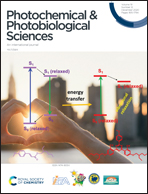High fatigue resistance of a photochromic dithienylethene embedded into the pores of a metal–organic framework (MOF)†
Abstract
The incorporation of photochromic dyes into porous metal–organic frameworks (MOFs) is an attractive way to transfer the photochromic properties of the dye to a solid crystalline material. In this work, the well-known P-type chromophore 1,2-bis[2-methylbenzo[b]thiophen-3-yl]-3,3,4,4,5,5-hexafluoro-1-cyclopentene (DTE) is embedded in three different MOFs, namely MOF-5, MIL-68(In), and MIL-68(Ga). The successful filling of the MOF pores with the DTE guest was proven by X-ray powder diffraction, while the amount of the embedded guest molecules was investigated by X-ray photoelectron spectroscopy (XPS), liquid-state NMR and thermal analysis (DSC/TGA). The measurements reveal an unexpectedly low filling of the MOF pores with the DTE guest (e.g. in MOF-5 only every fifth MOF pore is filled with a guest molecule) as well as an inhomogeneous loading throughout the material. Reflection spectra clearly show the transitions of the colourless open-ring and the coloured closed-ring forms of the DTE guest upon UV (λ = 365 nm), blue (λ = 405 nm) and green (λ = 535 nm) light exposure, where the latter is usually suppressed in crystalline DTE. Remarkably, no fatigue after ten switching cycles was observed and a high thermal stability of the coloured closed-ring form (at 50 °C for 1 h) was achieved.



 Please wait while we load your content...
Please wait while we load your content...